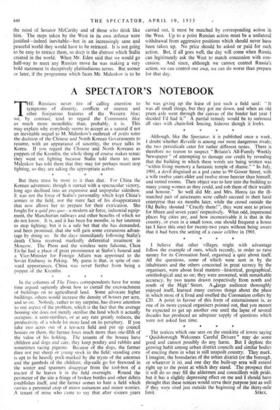In the columns of The Thnes correspondents have for some
time argued sapiently about how to curtail the encroachment of buildings on to agricultural land. Some advocate higher buildings, others would increase the density of houses per acre, and so on. Nobody, rather to my surprise, has drawn attention to one aspect of the problem, which is the fact that the average housing site does not merely sterilise the land which it actually occupies; it semi-sterilises, or at any rate greatly reduces, the productivity of a whole lot more land on its periphery. If you take two acres out of a ten-acre field and put up council houses on them, the farmer loses much, more than one-fifth of the value of his holding. The tenants of the houses have children and dogs and cats; they keep poultry and rabbits and sometimes racing pigeons. Because of the dogs, the farmer dare not put sheep or young stock in the field; standing corn is apt to be heavily pock-marked by the trysts of the amorous and the gambols of the children; slip-rails go for firewood in the winter and spanners disappear from the tool-box of a tractor if he leaves it in the field overnight. Round the perimeter of the site a fringe of broken bottles and other debris establishes itself. and the farmer oomes to hate a field which carries a perennial crop of minor nuisances and minor worries. A tenant of mine who came to say that after sixteen years he was giving up the lease of just such a field said : " It was all small things, but they got me down, and when an old pram axle went through the canvas of the binder last year I decided I'd had it." A partial remedy would be to surround all sites with chain-link fencing, hideous though it looks.


































 Previous page
Previous page